Business Process Management: A Report on Wong, Tseng, and Tan's Paper
VerifiedAdded on 2022/11/30
|8
|2203
|457
Report
AI Summary
This report analyzes the academic paper "A business process management capabilities perspective on organisation performance" by Wong, Tseng, and Tan (2014). The report discusses the main intention of the article, which focuses on the impact of BPM capabilities on organizational performance. It details the research methods, including the use of surveys and analysis of data from 182 organizations. The findings highlight the positive impact of managerial commitment and employee involvement on technical capabilities. The report also identifies problems, such as the limitations in technical and managerial capabilities' operationalization and the impact of BPM budgets. The conclusion emphasizes the importance of BPM in enhancing organizational performance through structured processes and employee involvement. The paper also provides insights into the dimensions of BPM capabilities and their interconnections, along with practical applications for organizations.
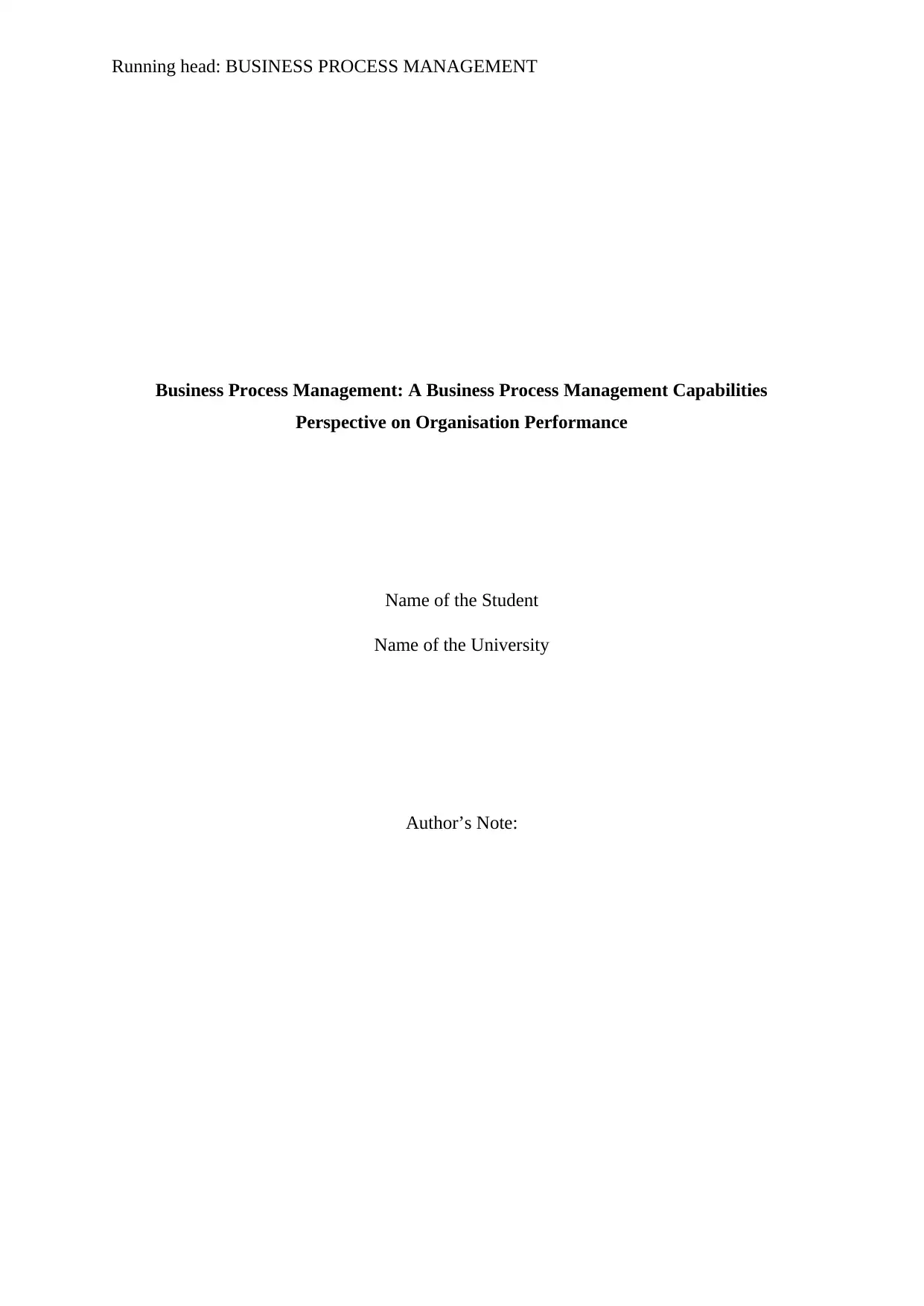
Running head: BUSINESS PROCESS MANAGEMENT
Business Process Management: A Business Process Management Capabilities
Perspective on Organisation Performance
Name of the Student
Name of the University
Author’s Note:
Business Process Management: A Business Process Management Capabilities
Perspective on Organisation Performance
Name of the Student
Name of the University
Author’s Note:
Paraphrase This Document
Need a fresh take? Get an instant paraphrase of this document with our AI Paraphraser
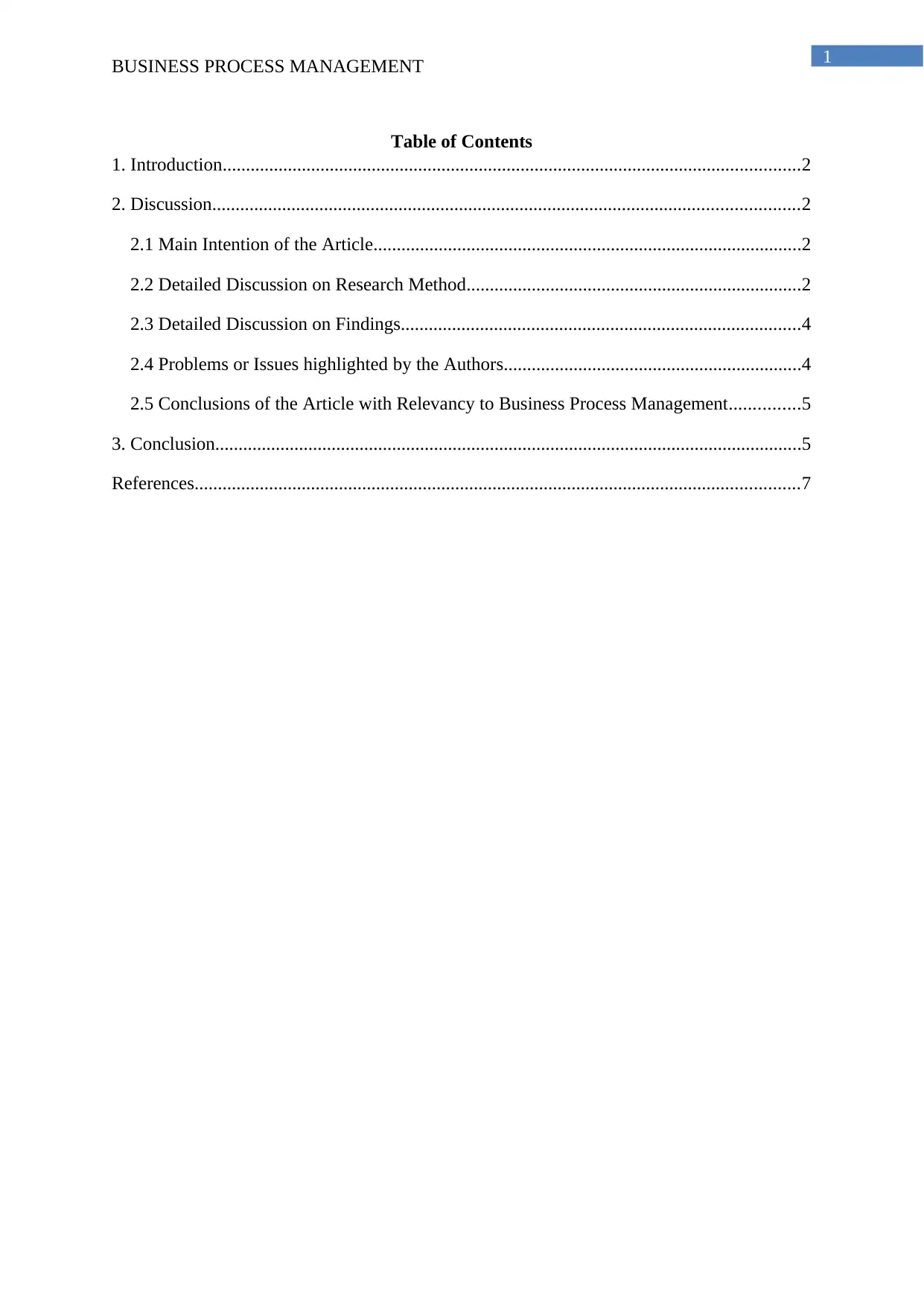
1
BUSINESS PROCESS MANAGEMENT
Table of Contents
1. Introduction............................................................................................................................2
2. Discussion..............................................................................................................................2
2.1 Main Intention of the Article............................................................................................2
2.2 Detailed Discussion on Research Method........................................................................2
2.3 Detailed Discussion on Findings......................................................................................4
2.4 Problems or Issues highlighted by the Authors................................................................4
2.5 Conclusions of the Article with Relevancy to Business Process Management...............5
3. Conclusion..............................................................................................................................5
References..................................................................................................................................7
BUSINESS PROCESS MANAGEMENT
Table of Contents
1. Introduction............................................................................................................................2
2. Discussion..............................................................................................................................2
2.1 Main Intention of the Article............................................................................................2
2.2 Detailed Discussion on Research Method........................................................................2
2.3 Detailed Discussion on Findings......................................................................................4
2.4 Problems or Issues highlighted by the Authors................................................................4
2.5 Conclusions of the Article with Relevancy to Business Process Management...............5
3. Conclusion..............................................................................................................................5
References..................................................................................................................................7
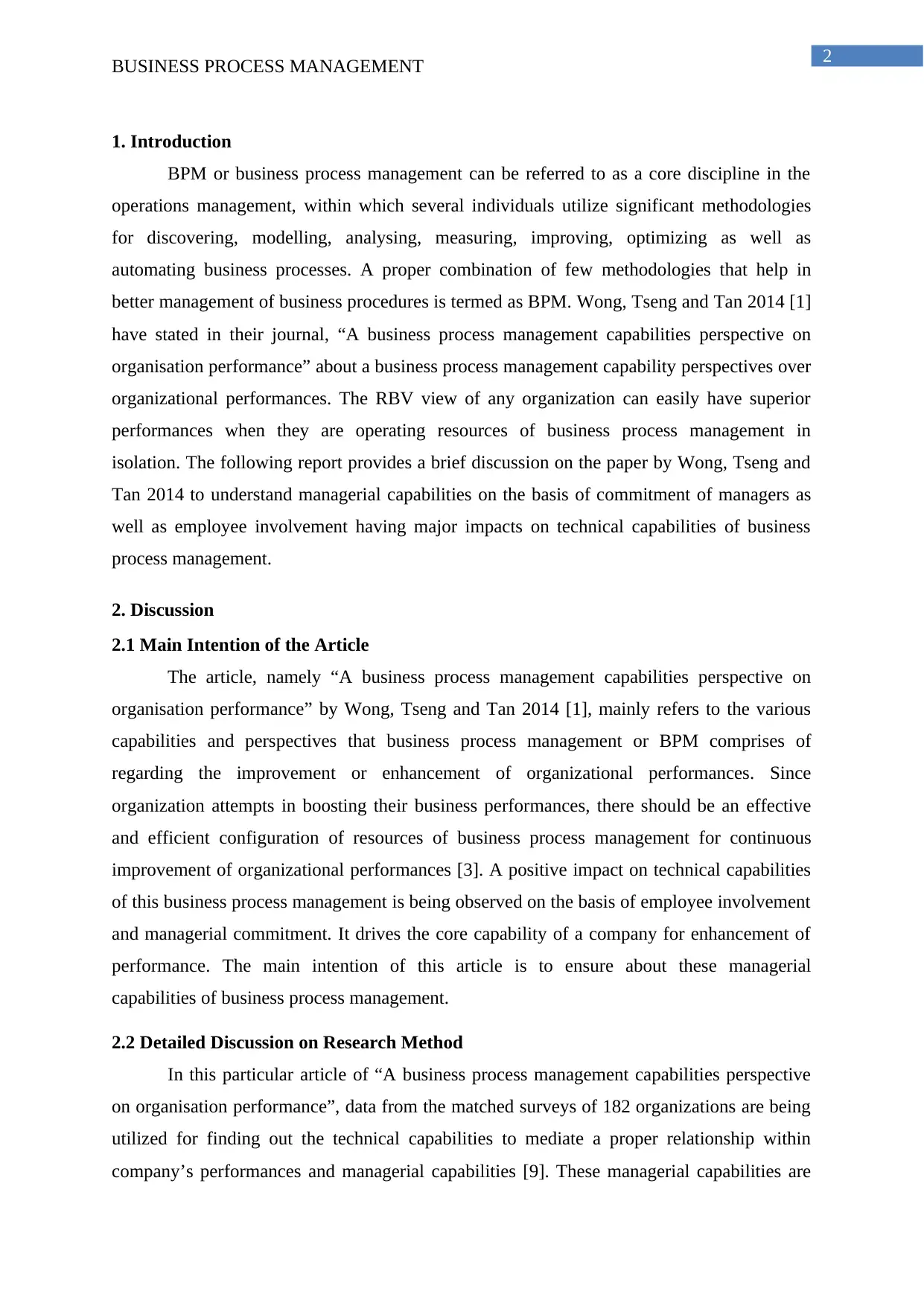
2
BUSINESS PROCESS MANAGEMENT
1. Introduction
BPM or business process management can be referred to as a core discipline in the
operations management, within which several individuals utilize significant methodologies
for discovering, modelling, analysing, measuring, improving, optimizing as well as
automating business processes. A proper combination of few methodologies that help in
better management of business procedures is termed as BPM. Wong, Tseng and Tan 2014 [1]
have stated in their journal, “A business process management capabilities perspective on
organisation performance” about a business process management capability perspectives over
organizational performances. The RBV view of any organization can easily have superior
performances when they are operating resources of business process management in
isolation. The following report provides a brief discussion on the paper by Wong, Tseng and
Tan 2014 to understand managerial capabilities on the basis of commitment of managers as
well as employee involvement having major impacts on technical capabilities of business
process management.
2. Discussion
2.1 Main Intention of the Article
The article, namely “A business process management capabilities perspective on
organisation performance” by Wong, Tseng and Tan 2014 [1], mainly refers to the various
capabilities and perspectives that business process management or BPM comprises of
regarding the improvement or enhancement of organizational performances. Since
organization attempts in boosting their business performances, there should be an effective
and efficient configuration of resources of business process management for continuous
improvement of organizational performances [3]. A positive impact on technical capabilities
of this business process management is being observed on the basis of employee involvement
and managerial commitment. It drives the core capability of a company for enhancement of
performance. The main intention of this article is to ensure about these managerial
capabilities of business process management.
2.2 Detailed Discussion on Research Method
In this particular article of “A business process management capabilities perspective
on organisation performance”, data from the matched surveys of 182 organizations are being
utilized for finding out the technical capabilities to mediate a proper relationship within
company’s performances and managerial capabilities [9]. These managerial capabilities are
BUSINESS PROCESS MANAGEMENT
1. Introduction
BPM or business process management can be referred to as a core discipline in the
operations management, within which several individuals utilize significant methodologies
for discovering, modelling, analysing, measuring, improving, optimizing as well as
automating business processes. A proper combination of few methodologies that help in
better management of business procedures is termed as BPM. Wong, Tseng and Tan 2014 [1]
have stated in their journal, “A business process management capabilities perspective on
organisation performance” about a business process management capability perspectives over
organizational performances. The RBV view of any organization can easily have superior
performances when they are operating resources of business process management in
isolation. The following report provides a brief discussion on the paper by Wong, Tseng and
Tan 2014 to understand managerial capabilities on the basis of commitment of managers as
well as employee involvement having major impacts on technical capabilities of business
process management.
2. Discussion
2.1 Main Intention of the Article
The article, namely “A business process management capabilities perspective on
organisation performance” by Wong, Tseng and Tan 2014 [1], mainly refers to the various
capabilities and perspectives that business process management or BPM comprises of
regarding the improvement or enhancement of organizational performances. Since
organization attempts in boosting their business performances, there should be an effective
and efficient configuration of resources of business process management for continuous
improvement of organizational performances [3]. A positive impact on technical capabilities
of this business process management is being observed on the basis of employee involvement
and managerial commitment. It drives the core capability of a company for enhancement of
performance. The main intention of this article is to ensure about these managerial
capabilities of business process management.
2.2 Detailed Discussion on Research Method
In this particular article of “A business process management capabilities perspective
on organisation performance”, data from the matched surveys of 182 organizations are being
utilized for finding out the technical capabilities to mediate a proper relationship within
company’s performances and managerial capabilities [9]. These managerial capabilities are
⊘ This is a preview!⊘
Do you want full access?
Subscribe today to unlock all pages.

Trusted by 1+ million students worldwide
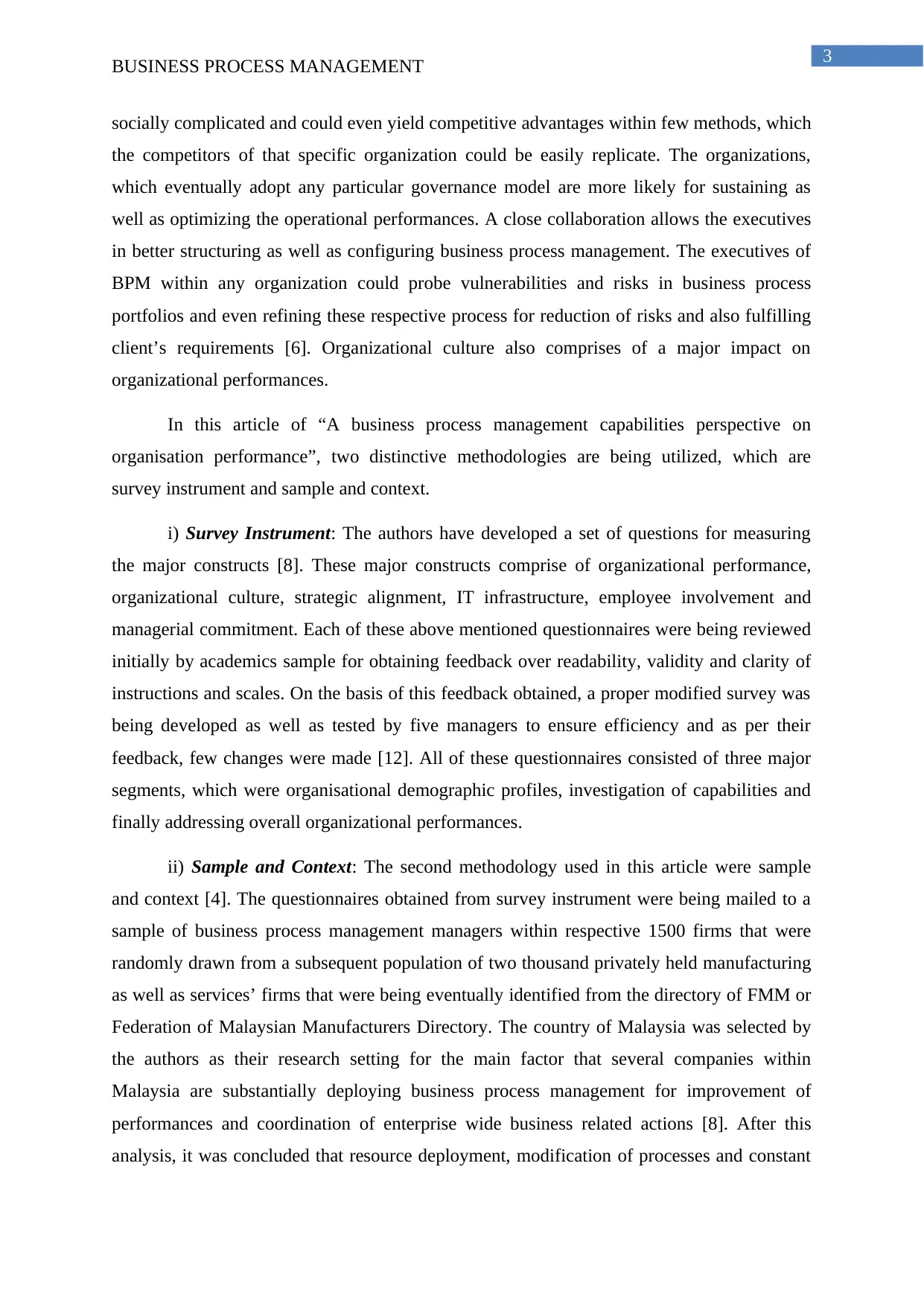
3
BUSINESS PROCESS MANAGEMENT
socially complicated and could even yield competitive advantages within few methods, which
the competitors of that specific organization could be easily replicate. The organizations,
which eventually adopt any particular governance model are more likely for sustaining as
well as optimizing the operational performances. A close collaboration allows the executives
in better structuring as well as configuring business process management. The executives of
BPM within any organization could probe vulnerabilities and risks in business process
portfolios and even refining these respective process for reduction of risks and also fulfilling
client’s requirements [6]. Organizational culture also comprises of a major impact on
organizational performances.
In this article of “A business process management capabilities perspective on
organisation performance”, two distinctive methodologies are being utilized, which are
survey instrument and sample and context.
i) Survey Instrument: The authors have developed a set of questions for measuring
the major constructs [8]. These major constructs comprise of organizational performance,
organizational culture, strategic alignment, IT infrastructure, employee involvement and
managerial commitment. Each of these above mentioned questionnaires were being reviewed
initially by academics sample for obtaining feedback over readability, validity and clarity of
instructions and scales. On the basis of this feedback obtained, a proper modified survey was
being developed as well as tested by five managers to ensure efficiency and as per their
feedback, few changes were made [12]. All of these questionnaires consisted of three major
segments, which were organisational demographic profiles, investigation of capabilities and
finally addressing overall organizational performances.
ii) Sample and Context: The second methodology used in this article were sample
and context [4]. The questionnaires obtained from survey instrument were being mailed to a
sample of business process management managers within respective 1500 firms that were
randomly drawn from a subsequent population of two thousand privately held manufacturing
as well as services’ firms that were being eventually identified from the directory of FMM or
Federation of Malaysian Manufacturers Directory. The country of Malaysia was selected by
the authors as their research setting for the main factor that several companies within
Malaysia are substantially deploying business process management for improvement of
performances and coordination of enterprise wide business related actions [8]. After this
analysis, it was concluded that resource deployment, modification of processes and constant
BUSINESS PROCESS MANAGEMENT
socially complicated and could even yield competitive advantages within few methods, which
the competitors of that specific organization could be easily replicate. The organizations,
which eventually adopt any particular governance model are more likely for sustaining as
well as optimizing the operational performances. A close collaboration allows the executives
in better structuring as well as configuring business process management. The executives of
BPM within any organization could probe vulnerabilities and risks in business process
portfolios and even refining these respective process for reduction of risks and also fulfilling
client’s requirements [6]. Organizational culture also comprises of a major impact on
organizational performances.
In this article of “A business process management capabilities perspective on
organisation performance”, two distinctive methodologies are being utilized, which are
survey instrument and sample and context.
i) Survey Instrument: The authors have developed a set of questions for measuring
the major constructs [8]. These major constructs comprise of organizational performance,
organizational culture, strategic alignment, IT infrastructure, employee involvement and
managerial commitment. Each of these above mentioned questionnaires were being reviewed
initially by academics sample for obtaining feedback over readability, validity and clarity of
instructions and scales. On the basis of this feedback obtained, a proper modified survey was
being developed as well as tested by five managers to ensure efficiency and as per their
feedback, few changes were made [12]. All of these questionnaires consisted of three major
segments, which were organisational demographic profiles, investigation of capabilities and
finally addressing overall organizational performances.
ii) Sample and Context: The second methodology used in this article were sample
and context [4]. The questionnaires obtained from survey instrument were being mailed to a
sample of business process management managers within respective 1500 firms that were
randomly drawn from a subsequent population of two thousand privately held manufacturing
as well as services’ firms that were being eventually identified from the directory of FMM or
Federation of Malaysian Manufacturers Directory. The country of Malaysia was selected by
the authors as their research setting for the main factor that several companies within
Malaysia are substantially deploying business process management for improvement of
performances and coordination of enterprise wide business related actions [8]. After this
analysis, it was concluded that resource deployment, modification of processes and constant
Paraphrase This Document
Need a fresh take? Get an instant paraphrase of this document with our AI Paraphraser
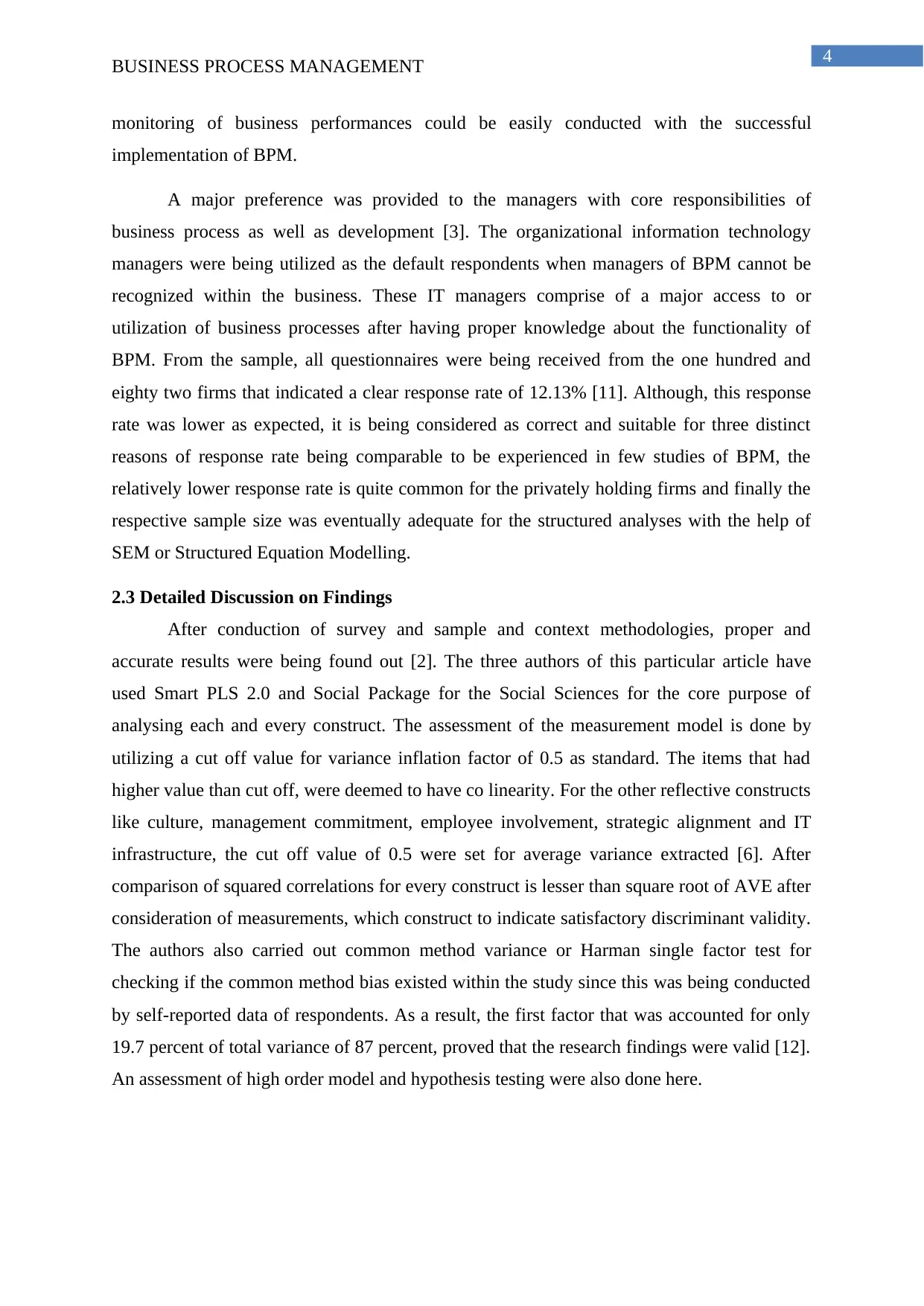
4
BUSINESS PROCESS MANAGEMENT
monitoring of business performances could be easily conducted with the successful
implementation of BPM.
A major preference was provided to the managers with core responsibilities of
business process as well as development [3]. The organizational information technology
managers were being utilized as the default respondents when managers of BPM cannot be
recognized within the business. These IT managers comprise of a major access to or
utilization of business processes after having proper knowledge about the functionality of
BPM. From the sample, all questionnaires were being received from the one hundred and
eighty two firms that indicated a clear response rate of 12.13% [11]. Although, this response
rate was lower as expected, it is being considered as correct and suitable for three distinct
reasons of response rate being comparable to be experienced in few studies of BPM, the
relatively lower response rate is quite common for the privately holding firms and finally the
respective sample size was eventually adequate for the structured analyses with the help of
SEM or Structured Equation Modelling.
2.3 Detailed Discussion on Findings
After conduction of survey and sample and context methodologies, proper and
accurate results were being found out [2]. The three authors of this particular article have
used Smart PLS 2.0 and Social Package for the Social Sciences for the core purpose of
analysing each and every construct. The assessment of the measurement model is done by
utilizing a cut off value for variance inflation factor of 0.5 as standard. The items that had
higher value than cut off, were deemed to have co linearity. For the other reflective constructs
like culture, management commitment, employee involvement, strategic alignment and IT
infrastructure, the cut off value of 0.5 were set for average variance extracted [6]. After
comparison of squared correlations for every construct is lesser than square root of AVE after
consideration of measurements, which construct to indicate satisfactory discriminant validity.
The authors also carried out common method variance or Harman single factor test for
checking if the common method bias existed within the study since this was being conducted
by self-reported data of respondents. As a result, the first factor that was accounted for only
19.7 percent of total variance of 87 percent, proved that the research findings were valid [12].
An assessment of high order model and hypothesis testing were also done here.
BUSINESS PROCESS MANAGEMENT
monitoring of business performances could be easily conducted with the successful
implementation of BPM.
A major preference was provided to the managers with core responsibilities of
business process as well as development [3]. The organizational information technology
managers were being utilized as the default respondents when managers of BPM cannot be
recognized within the business. These IT managers comprise of a major access to or
utilization of business processes after having proper knowledge about the functionality of
BPM. From the sample, all questionnaires were being received from the one hundred and
eighty two firms that indicated a clear response rate of 12.13% [11]. Although, this response
rate was lower as expected, it is being considered as correct and suitable for three distinct
reasons of response rate being comparable to be experienced in few studies of BPM, the
relatively lower response rate is quite common for the privately holding firms and finally the
respective sample size was eventually adequate for the structured analyses with the help of
SEM or Structured Equation Modelling.
2.3 Detailed Discussion on Findings
After conduction of survey and sample and context methodologies, proper and
accurate results were being found out [2]. The three authors of this particular article have
used Smart PLS 2.0 and Social Package for the Social Sciences for the core purpose of
analysing each and every construct. The assessment of the measurement model is done by
utilizing a cut off value for variance inflation factor of 0.5 as standard. The items that had
higher value than cut off, were deemed to have co linearity. For the other reflective constructs
like culture, management commitment, employee involvement, strategic alignment and IT
infrastructure, the cut off value of 0.5 were set for average variance extracted [6]. After
comparison of squared correlations for every construct is lesser than square root of AVE after
consideration of measurements, which construct to indicate satisfactory discriminant validity.
The authors also carried out common method variance or Harman single factor test for
checking if the common method bias existed within the study since this was being conducted
by self-reported data of respondents. As a result, the first factor that was accounted for only
19.7 percent of total variance of 87 percent, proved that the research findings were valid [12].
An assessment of high order model and hypothesis testing were also done here.
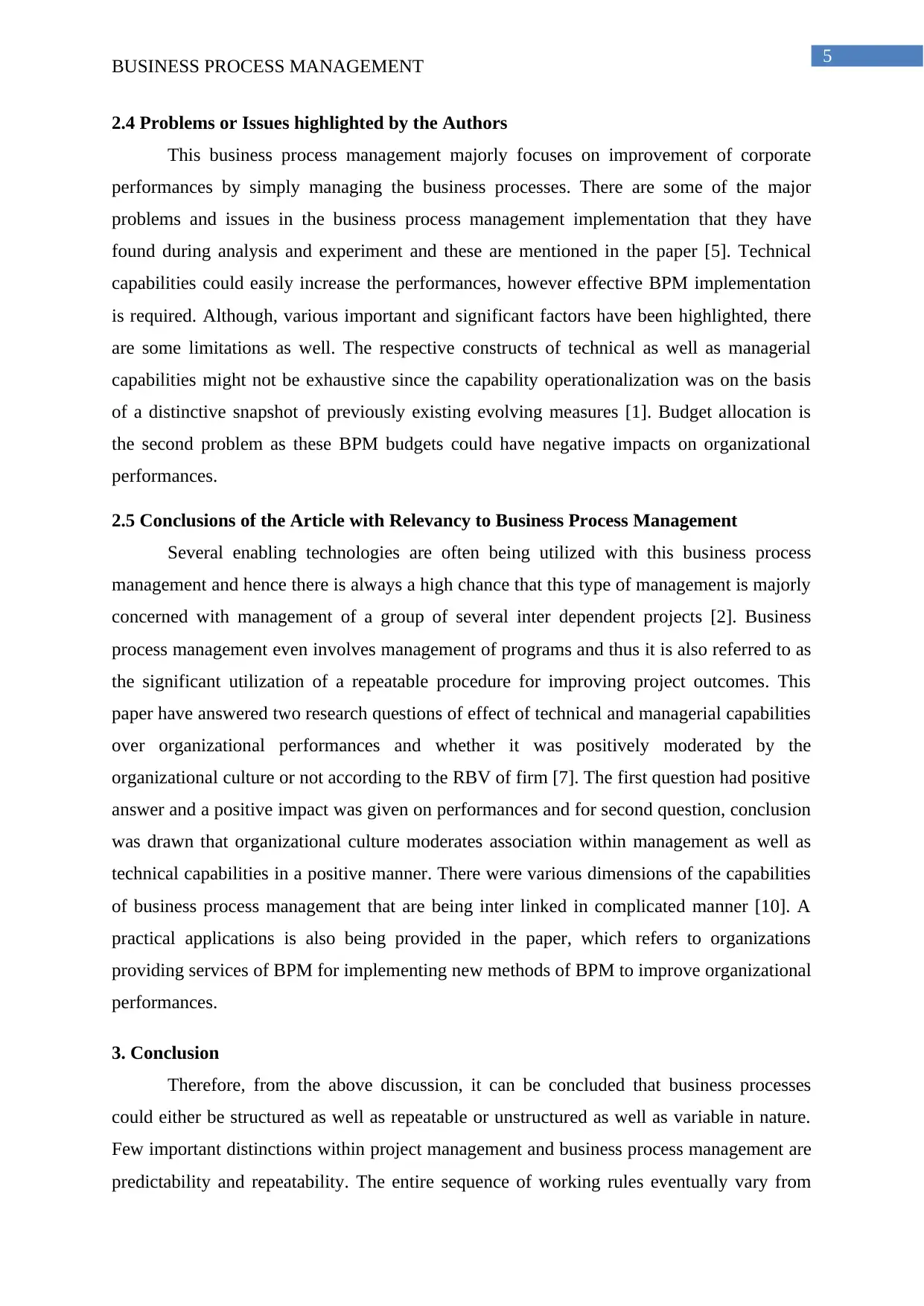
5
BUSINESS PROCESS MANAGEMENT
2.4 Problems or Issues highlighted by the Authors
This business process management majorly focuses on improvement of corporate
performances by simply managing the business processes. There are some of the major
problems and issues in the business process management implementation that they have
found during analysis and experiment and these are mentioned in the paper [5]. Technical
capabilities could easily increase the performances, however effective BPM implementation
is required. Although, various important and significant factors have been highlighted, there
are some limitations as well. The respective constructs of technical as well as managerial
capabilities might not be exhaustive since the capability operationalization was on the basis
of a distinctive snapshot of previously existing evolving measures [1]. Budget allocation is
the second problem as these BPM budgets could have negative impacts on organizational
performances.
2.5 Conclusions of the Article with Relevancy to Business Process Management
Several enabling technologies are often being utilized with this business process
management and hence there is always a high chance that this type of management is majorly
concerned with management of a group of several inter dependent projects [2]. Business
process management even involves management of programs and thus it is also referred to as
the significant utilization of a repeatable procedure for improving project outcomes. This
paper have answered two research questions of effect of technical and managerial capabilities
over organizational performances and whether it was positively moderated by the
organizational culture or not according to the RBV of firm [7]. The first question had positive
answer and a positive impact was given on performances and for second question, conclusion
was drawn that organizational culture moderates association within management as well as
technical capabilities in a positive manner. There were various dimensions of the capabilities
of business process management that are being inter linked in complicated manner [10]. A
practical applications is also being provided in the paper, which refers to organizations
providing services of BPM for implementing new methods of BPM to improve organizational
performances.
3. Conclusion
Therefore, from the above discussion, it can be concluded that business processes
could either be structured as well as repeatable or unstructured as well as variable in nature.
Few important distinctions within project management and business process management are
predictability and repeatability. The entire sequence of working rules eventually vary from
BUSINESS PROCESS MANAGEMENT
2.4 Problems or Issues highlighted by the Authors
This business process management majorly focuses on improvement of corporate
performances by simply managing the business processes. There are some of the major
problems and issues in the business process management implementation that they have
found during analysis and experiment and these are mentioned in the paper [5]. Technical
capabilities could easily increase the performances, however effective BPM implementation
is required. Although, various important and significant factors have been highlighted, there
are some limitations as well. The respective constructs of technical as well as managerial
capabilities might not be exhaustive since the capability operationalization was on the basis
of a distinctive snapshot of previously existing evolving measures [1]. Budget allocation is
the second problem as these BPM budgets could have negative impacts on organizational
performances.
2.5 Conclusions of the Article with Relevancy to Business Process Management
Several enabling technologies are often being utilized with this business process
management and hence there is always a high chance that this type of management is majorly
concerned with management of a group of several inter dependent projects [2]. Business
process management even involves management of programs and thus it is also referred to as
the significant utilization of a repeatable procedure for improving project outcomes. This
paper have answered two research questions of effect of technical and managerial capabilities
over organizational performances and whether it was positively moderated by the
organizational culture or not according to the RBV of firm [7]. The first question had positive
answer and a positive impact was given on performances and for second question, conclusion
was drawn that organizational culture moderates association within management as well as
technical capabilities in a positive manner. There were various dimensions of the capabilities
of business process management that are being inter linked in complicated manner [10]. A
practical applications is also being provided in the paper, which refers to organizations
providing services of BPM for implementing new methods of BPM to improve organizational
performances.
3. Conclusion
Therefore, from the above discussion, it can be concluded that business processes
could either be structured as well as repeatable or unstructured as well as variable in nature.
Few important distinctions within project management and business process management are
predictability and repeatability. The entire sequence of working rules eventually vary from
⊘ This is a preview!⊘
Do you want full access?
Subscribe today to unlock all pages.

Trusted by 1+ million students worldwide

6
BUSINESS PROCESS MANAGEMENT
several instances within this business process management like business rules, conditions and
gateways. Organizational performances are enhanced with proper involvement of this
management since it increases employee performances. The above provided report has
clearly outlined about details of business process management mentioned in the article with
relevant description.
BUSINESS PROCESS MANAGEMENT
several instances within this business process management like business rules, conditions and
gateways. Organizational performances are enhanced with proper involvement of this
management since it increases employee performances. The above provided report has
clearly outlined about details of business process management mentioned in the article with
relevant description.
Paraphrase This Document
Need a fresh take? Get an instant paraphrase of this document with our AI Paraphraser
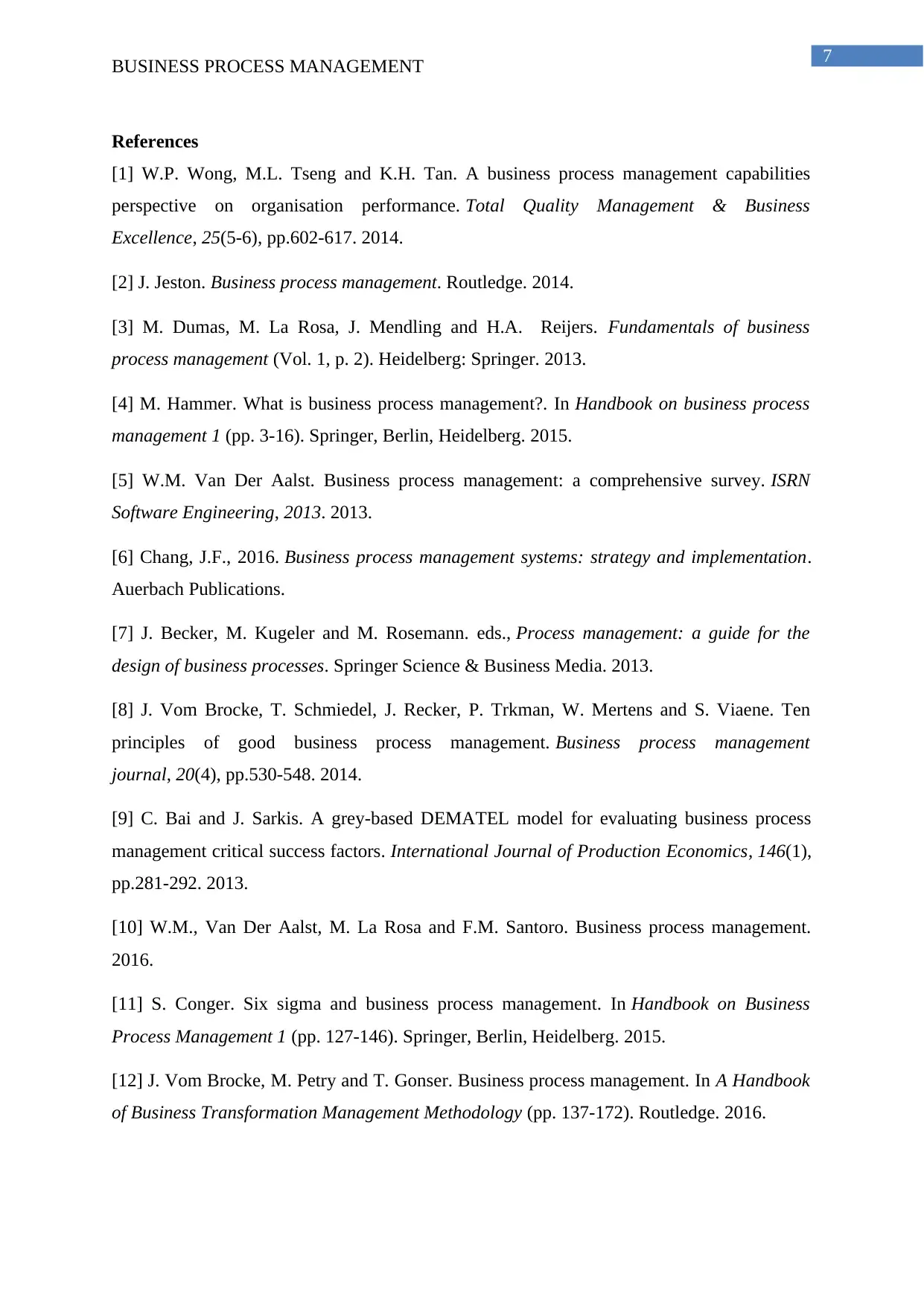
7
BUSINESS PROCESS MANAGEMENT
References
[1] W.P. Wong, M.L. Tseng and K.H. Tan. A business process management capabilities
perspective on organisation performance. Total Quality Management & Business
Excellence, 25(5-6), pp.602-617. 2014.
[2] J. Jeston. Business process management. Routledge. 2014.
[3] M. Dumas, M. La Rosa, J. Mendling and H.A. Reijers. Fundamentals of business
process management (Vol. 1, p. 2). Heidelberg: Springer. 2013.
[4] M. Hammer. What is business process management?. In Handbook on business process
management 1 (pp. 3-16). Springer, Berlin, Heidelberg. 2015.
[5] W.M. Van Der Aalst. Business process management: a comprehensive survey. ISRN
Software Engineering, 2013. 2013.
[6] Chang, J.F., 2016. Business process management systems: strategy and implementation.
Auerbach Publications.
[7] J. Becker, M. Kugeler and M. Rosemann. eds., Process management: a guide for the
design of business processes. Springer Science & Business Media. 2013.
[8] J. Vom Brocke, T. Schmiedel, J. Recker, P. Trkman, W. Mertens and S. Viaene. Ten
principles of good business process management. Business process management
journal, 20(4), pp.530-548. 2014.
[9] C. Bai and J. Sarkis. A grey-based DEMATEL model for evaluating business process
management critical success factors. International Journal of Production Economics, 146(1),
pp.281-292. 2013.
[10] W.M., Van Der Aalst, M. La Rosa and F.M. Santoro. Business process management.
2016.
[11] S. Conger. Six sigma and business process management. In Handbook on Business
Process Management 1 (pp. 127-146). Springer, Berlin, Heidelberg. 2015.
[12] J. Vom Brocke, M. Petry and T. Gonser. Business process management. In A Handbook
of Business Transformation Management Methodology (pp. 137-172). Routledge. 2016.
BUSINESS PROCESS MANAGEMENT
References
[1] W.P. Wong, M.L. Tseng and K.H. Tan. A business process management capabilities
perspective on organisation performance. Total Quality Management & Business
Excellence, 25(5-6), pp.602-617. 2014.
[2] J. Jeston. Business process management. Routledge. 2014.
[3] M. Dumas, M. La Rosa, J. Mendling and H.A. Reijers. Fundamentals of business
process management (Vol. 1, p. 2). Heidelberg: Springer. 2013.
[4] M. Hammer. What is business process management?. In Handbook on business process
management 1 (pp. 3-16). Springer, Berlin, Heidelberg. 2015.
[5] W.M. Van Der Aalst. Business process management: a comprehensive survey. ISRN
Software Engineering, 2013. 2013.
[6] Chang, J.F., 2016. Business process management systems: strategy and implementation.
Auerbach Publications.
[7] J. Becker, M. Kugeler and M. Rosemann. eds., Process management: a guide for the
design of business processes. Springer Science & Business Media. 2013.
[8] J. Vom Brocke, T. Schmiedel, J. Recker, P. Trkman, W. Mertens and S. Viaene. Ten
principles of good business process management. Business process management
journal, 20(4), pp.530-548. 2014.
[9] C. Bai and J. Sarkis. A grey-based DEMATEL model for evaluating business process
management critical success factors. International Journal of Production Economics, 146(1),
pp.281-292. 2013.
[10] W.M., Van Der Aalst, M. La Rosa and F.M. Santoro. Business process management.
2016.
[11] S. Conger. Six sigma and business process management. In Handbook on Business
Process Management 1 (pp. 127-146). Springer, Berlin, Heidelberg. 2015.
[12] J. Vom Brocke, M. Petry and T. Gonser. Business process management. In A Handbook
of Business Transformation Management Methodology (pp. 137-172). Routledge. 2016.
1 out of 8
Related Documents
Your All-in-One AI-Powered Toolkit for Academic Success.
+13062052269
info@desklib.com
Available 24*7 on WhatsApp / Email
![[object Object]](/_next/static/media/star-bottom.7253800d.svg)
Unlock your academic potential
Copyright © 2020–2025 A2Z Services. All Rights Reserved. Developed and managed by ZUCOL.





